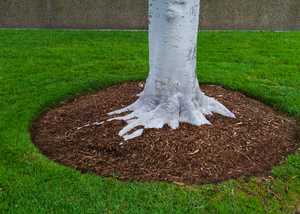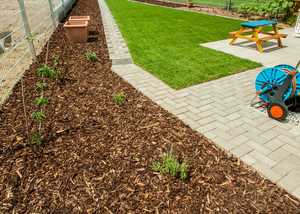Mulch and Mulching
While woodland mulch might not be the most glamorous item in our range—it’s certainly one of the most versatile!
Suitable for a wide variety of landscape and gardening projects, both domestic and commercial, mulch is a hugely popular product with our customers. Whether it’s for suppressing weeds in a flower bed, or protecting delicate tree roots while civil engineers and contractors dig and lay pipes, this sustainable and environmentally-friendly product is sure to offer brilliant results.
What is mulch?
Mulch is a dense layer of material that can be deposited over soil and around trees and plant life. Its primary function is to mitigate weed growth and lock precious moisture into the earth. It’s also an excellent solution for protecting the soil against drying winds and direct sunlight.
Some mulches have the added benefit of containing nutrients, which act as a slow-release food source for plants. Meanwhile, worms will happily transfer the mulch into the soil and help improve its structure and fertility, leading to yet more moisture retention.
Fundamentally, mulches can be divided into two groups; biodegradable and non-biodegradable. While both are adept at keeping weeds at bay and conserving moisture in the soil, only organic mulches contain vital nutrients for plants. On top of that, while organic mulch breaks down, it becomes an attractive proposition for beetles, worms, and other soil invertebrates—which provide sustenance for birds visiting your garden.


The benefits of using mulch
Mulching has a long and varied list of benefits and practical uses. Organic mulches not only help protect tree roots and boost growth, they significantly enhance the long-term health of the trees.
Mulching also provides essential nutrients for your plant life, increases moisture retention in the soil, suppresses weeds, reduces temperature fluctuation, and improves soil structure. It’s also a brilliant way of improving the aesthetic of an outdoor area; masking and tidying up portions of a garden with a consistent layer of organic material.
When to apply mulch
The optimal time to apply mulch is mid-to-late spring, when the annual weeds have not yet germinated and the herbaceous plants are still dormant. Failing that, autumn offers a good chance to deposit your organic mulch, as plant life is beginning to die back and minimal groundwork is needed before applying your product.
Mulch can be applied in areas around new plants or in already-established beds. Indeed, weed suppression and moisture retention are vital components in the early stages of a plant’s life cycle, so those specimens that require time to root can benefit from mulch all year round.
What type of mulches are available?
There’s a wide range of mulches available—both organic and inorganic— for an equally varied number of applications. Organic mulches generally consist of dead plant material such as compost, leaves, and grass clippings—or wood chippings, tree cuttings, and processed bark.
Meanwhile, inorganic mulches include stones, gravel and rocks—as well as plastic sheeting, landscape fabric, and shredded rubber. The key feature of organic mulch compared to inorganic is that it decomposes naturally and is a much more environmentally sustainable option.
How can we help?
Fountain Timber Woodland Mulch is produced on-site from shredded tree cuttings sourced from local tree surgeons. The cuttings are then combined with bark and timber chips and left to heat up and break down organically. If you’d like to know more about mulch and its many benefits and uses or would like to enquire about a specific product, please get in touch.
Posted on February 8th 2022

